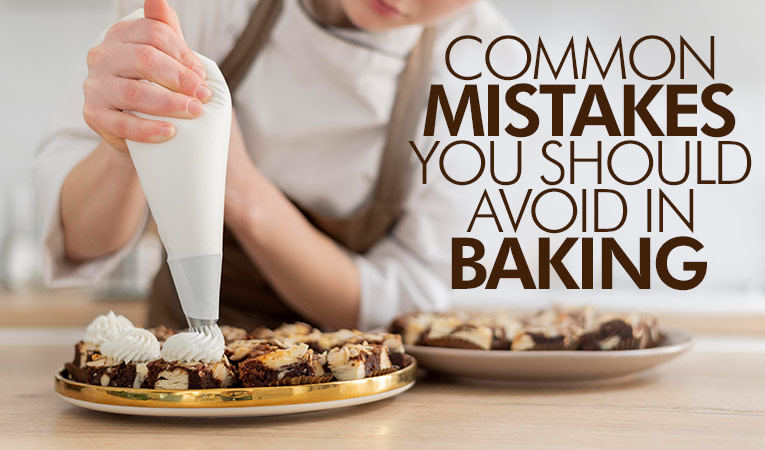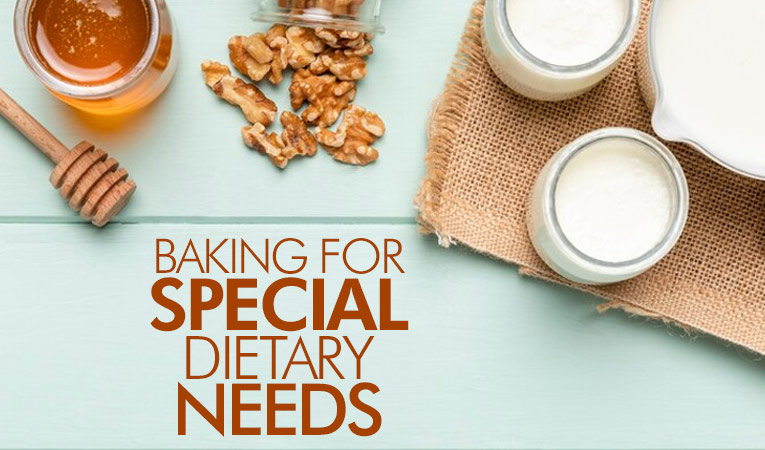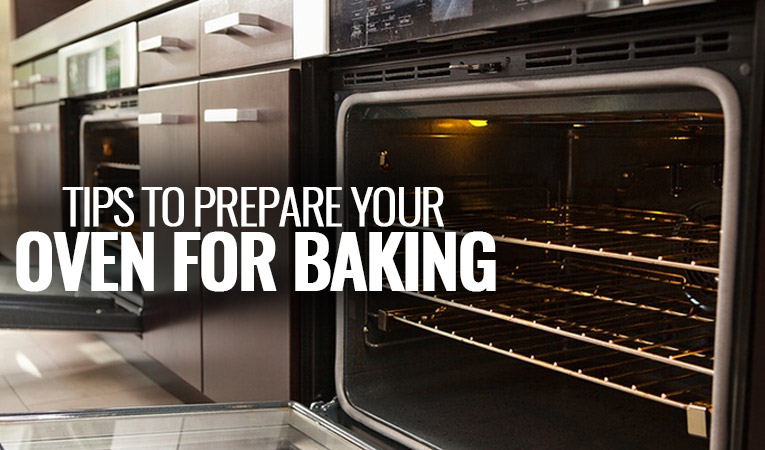Common mistakes you should avoid while Baking
10-12-2017

Baking is an art that demands precision and attention to detail. However, even experienced bakers can make common mistakes that can affect the taste and texture of their creations. In this comprehensive guide, we will explore 15 baking mistakes to avoid, enabling you to consistently achieve outstanding results. By recognizing and rectifying these baking mistakes, you'll elevate your baking game and create mouthwatering treats that will impress your family and friends.
- Neglecting Accurate Flour Measurements: A baking mistake often made is neglecting precise flour measurements. Achieving the right amount of flour is crucial for successful baking. It is essential to follow the recipe and use the exact amount specified to avoid ending up with dry or dense results. Paying attention to this detail will ensure your baked goods turn out perfectly every time.
- Using Expired Baking Powder: Don't make the baking mistake of using expired baking powder. Using outdated baking powder can significantly impact the taste and rise of your baked goods. To avoid this, always check the expiration date and replace it when needed.
- Importance of Room Temperature Ingredients: One common baking mistake is using ingredients straight from the refrigerator. Incorporating room temperature ingredients is essential as it promotes proper emulsification and aeration, resulting in a superior texture in your baked treats. Allowing ingredients to come to room temperature before use ensures a harmonious blend and enhances the overall quality of your baked goods.
- Overmixing: The Culprit of Dense Baked Goods: Overmixing is a common baking mistake that can lead to dense and tough baked goods. When you overmix the batter, gluten develops excessively, resulting in undesirable texture. To avoid this baking mistake, be careful not to overmix. Mix the ingredients until just combined for a lighter and more tender texture in your baked treats.
- Step-by-Step Ingredient Incorporation: Following the recipe's instructions for adding ingredients in the specified order is crucial to avoid baking mistakes. Each step has a purpose in achieving optimal mixing and a well-balanced outcome. By carefully following the sequence, you ensure that each ingredient is incorporated correctly, resulting in a harmonious blend of flavors and textures in your final baked goods.
- Avoid Over-Flouring Wet Dough: One common baking mistake is adding excessive flour to sticky dough. While it may be tempting to keep adding flour to make the dough less sticky, it can lead to a dry and dense texture in the final product. Proper hydration and fermentation are essential for developing the desired flavor and texture in your baked goods. By resisting the urge to over-flour, you allow the dough to reach its optimal consistency, resulting in moist, tender, and flavorful treats.
- Patience Pays Off: Understanding Resting Stages: One of the baking mistakes to avoid is neglecting the resting stages in recipes. Resting periods allow the ingredients to harmonize, flavors to develop, and the texture to improve in your baked goods. Whether it's allowing the dough to rise, letting the batter rest before baking, or giving your cake time to cool, these moments of patience can make a significant difference in the final outcome. Embrace the resting stages as an essential part of the baking process and enjoy the enhanced flavors and textures they bring to your creations.
- The Power of Recipe Instructions: One of the most common baking mistakes is disregarding or deviating from the recipe instructions. Each step and technique outlined in the recipe is carefully designed to achieve the desired outcome. Whether it's the specific order of ingredient incorporation, the recommended mixing times, or the suggested oven temperature, following the recipe instructions meticulously is key to the overall success of your baking. Treat the recipe as your guide and trust in its instructions to help you achieve delicious and perfectly baked goods.
- Greasing and Parchment Paper: Your Baking Allies: Don't underestimate the importance of properly greasing your pans and using parchment paper in your baking endeavors. Greasing the pan ensures that your baked goods easily release without sticking to the surface. Additionally, lining the pan with parchment paper provides an extra layer of protection, preventing any potential sticking and allowing for a seamless removal of your treats. These simple steps will save you time and frustration, ensuring a smooth baking experience.
- Mastering Baking Time: The Key to Perfect Results: One of the crucial factors in achieving baking perfection is mastering the art of timing. Each recipe has its own ideal baking time, and it's essential to understand it to achieve the best results. While recipe instructions provide a general guideline, relying on visual and sensory cues is equally important. Keep a close eye on the color, texture, and aroma of your baked goods as they bake, and use a toothpick or cake tester to check for doneness. With practice and experience, you'll develop an intuition for the perfect baking time, ensuring that your treats come out of the oven beautifully baked every time.
- Improperly Measuring Ingredients: One of the common baking mistakes is inaccurate measurement of ingredients, which can significantly impact the final outcome of your baked goods. Whether it's liquids, spices, or dry ingredients like flour and sugar, precise measurements are essential for maintaining the right balance of flavors and textures. Use measuring cups and spoons designed for baking and follow the recipe instructions closely. Level off dry ingredients with a straight edge, and use a liquid measuring cup at eye level for accurate liquid measurements. By avoiding the mistake of improper ingredient measurement, you'll ensure consistent and delicious results in your baking endeavors.
- Using the Wrong Flour: Another common baking mistake is using the wrong type of flour for your recipes. Various flours have different protein contents, which directly impact the structure, texture, and overall success of your baked treats. It's essential to choose the appropriate flour for each recipe to achieve the desired results. For example, bread flour is high in protein, making it suitable for yeast-based bread, while cake flour has a lower protein content, resulting in lighter and more delicate cakes. Pay attention to the recommended flour types in your recipes and make the right selection to ensure the best outcome for your baked goods.
- Ignoring Oven Temperature Accuracy: One baking mistake that can significantly impact your results is ignoring the accuracy of your oven temperature. Ovens can often have temperature variations, leading to undercooked or over-baked goods. To avoid this, it's essential to calibrate your oven and ensure it maintains the correct temperature. An oven thermometer can be a handy tool to help you monitor and adjust the temperature for precise control. By using an oven thermometer, you can bake with confidence, knowing that your treats will be cooked to perfection.
- Using an Inappropriately Sized Cake Tin: Using a cake tin that is too small or too large for your recipe can result in uneven baking, collapsed or overflowed cakes, and an overall disappointing outcome. It's essential to follow the recipe's instructions regarding the recommended cake tin size to ensure even heat distribution and proper rise. Using the right-sized cake tin will help you achieve a beautifully baked cake with the perfect texture and appearance. So, always check your recipe and choose the appropriate cake tin to avoid this common baking mistake.
- Baking Too Many Things at Once: While it may be tempting to maximize your oven space and bake multiple items simultaneously, overcrowding the oven can lead to uneven heat distribution and hinder proper airflow. This can result in undercooked or overcooked baked goods. To avoid this mistake, bake in batches or use multiple oven racks, allowing sufficient space for air circulation around each item. By giving your baked goods enough room to bake evenly, you'll achieve consistent and delicious results.
Conclusion:
By being mindful of these common baking mistakes, you're well on your way to becoming a baking pro. Remember, the key to achieving consistently outstanding results lies in the details. So, measure your ingredients accurately, pay attention to room temperature, and follow those recipe instructions like a pro. Take the time to understand the impact of each step and technique, and don't be afraid to experiment and unleash your creativity. If you have any questions or need further guidance, don't hesitate to leave a comment below. Our baking community is here to support you on your journey. Happy baking, and may your culinary creations bring joy and deliciousness to your kitchen!
Note: For further guidance on baking techniques or to access high-quality baking supplies, visit our online store or contact us at hello@bakerykart.com. We are committed to supporting your baking journey and providing the finest tools and ingredients for your culinary creations.





